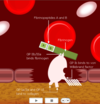Haemostasis Flashcards
(25 cards)
What is the vessel wall lined with and what are it’s characteristics?
- Epithelium
- “Non-stick surface teflon”
Which substances do we have to encourage flow?
- heparans, anticoagulants – TFPI, prostacyclin, nitric oxide

What happens when you are cut? What systems are at play?
- You bleed at the site of the injury
- For how long? 3-4 mins
- Stops – you form a clot Platelets, vWF, Coagulation Factors
- The clot remains confined to the site of injury Natural Anticoagulants
- 1 week later the clot has vanished Fibrinolytic System
What states are platelets and coagulation factors generally in the blood?
- Platelets and coag factors remain in resting state until activated – localised signals, production at area of damage of physiological activators cause activation
What causes platelets to adhere to site of damage?
- Platelets are seeing something not used to – subendothelial collagen, as soon as they see this they stick to it and become sitcky/activated.
- Vwfactor binds and allows us to start clotting. Just at area of damage there is physiological activator (tissue factor)

What exist on the surface of platelets and their roles?
- Receptors – normally for things created in context of trauma
- Glycoprotein receptors – capable of binding to ligands, relevant to blood coagulation
How do platelets work?
- Bind to collagen
- Bind to von willebrand factor
- Bind to fibrinogen

What are platelets role in haemostatis?
- Adhere
- Activate
- Aggregrate
- Provide phospholipid surface for coagulation
Which parts of the platelet are responsible for adherence?
- GP 1b
- GP1a (x2)
How do platelets activate?
- ADP pathway (P2Y12)
- Activation of cyclooxygenase pathway
What allows the aggregration of platelets?
- Thromboxane allows platelets to stick to each other
What allows proteins to attach to platelets?
Externalised phospholipids
What is the PRIMARY platelet plug?
- Platelets have adhered, activated and bound fibrinogen = PRIMARY haemostatic plug
What stabilises the primary platelet plug?
- Fibrin clot formation
How can we make a fibrin clot?
- Primary aim is to cleave fibrinogen..
So:
- There is a clotting cascade of proteins, much like a row of dominoes, they must all ‘fall over’ to finally cleave fibrinogen creating the fibrin clot

What happens if one of the coagulation factors is missing?
- Process is flawed, cascade doesn’t complete, continue bleeding
- Anticoagulants work by stopping the dominoes falling over!

What is the protein cascade pathway?
- 7a binds to 10, activates it,
- 10a with 5a activated thrombin – makes fibrin

What is the role of natural anticoagulants?
- To confine the clot to the area of damage
What are the three main natural anticoagulants?
- antithrombin
- activated protein C and S
- TFPI
How does TFPI function?
- TFPI inactivated activated form of tissue activator 7a and 10a – reduces amount of thrombin
How does protein C and S function?
- A5 and A8 – switches them off, reduces thrombin
How does antithrombin work?
- Inhibits 10a and thrombin, switching the process off
What is the process of fibrinolysis?
- Endothelial cells – produces activators of plasminogen.
- t-PA cleaves the bridge creating active plasmin (protease), starts to break fibrin clot down.
- Produces degradation products:
- D-dimer: piece of fibrin that has been broken down

What is the mechanism of antiplatelets?
- Aspirin prevents platelet from being sticky by preventing arachadonic acid forming thromboxane
- Clopidogrel/Ticagrelor – preventing platelet from sticking
- Other drugs normally used in coronary cath lab.


